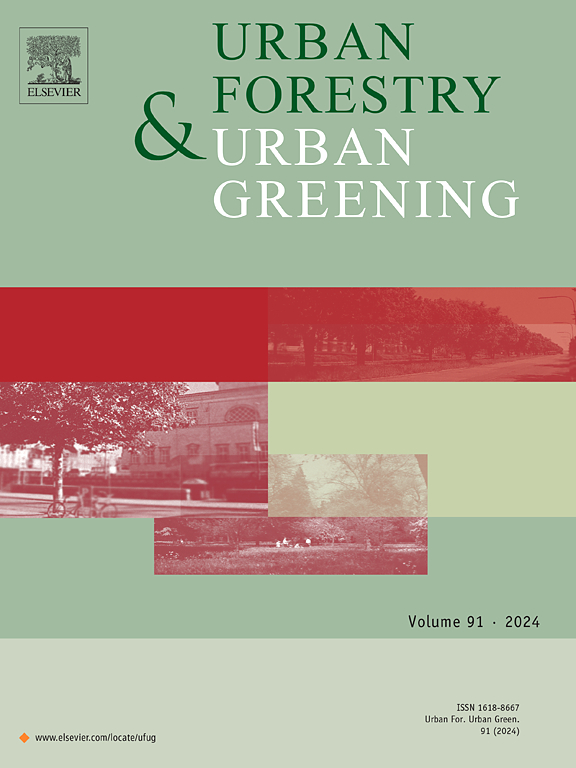Modelling the optimal green roof type for carbon capture in an urbanised university campus
IF 6
2区 环境科学与生态学
Q1 ENVIRONMENTAL STUDIES
引用次数: 0
Abstract
Carbon capture has been brought to the forefront of research in an effort to battle the climate crisis, but the physical space needed to implement necessary green infrastructure is sparse and only diminishing. Therefore, efforts to adapt and repurpose current infrastructure to house essential green space must be made. Green roofs offer a sustainable, nondestructive solution that can help to address climate-related issues in urbanised areas, such as poor air quality, lack of green space, and the urban heat island effect. Previous studies have highlighted the potential of green roofs in an urbanised environment with regard to these benefits, however, further scope remains to identify the combination of vegetation that present optimal efficiency for carbon sequestration in a temperate climate. This study focuses on improving the University of Bristol’s initial attempt of green roof implementation and provides a guideline for further expansion with emphasis on maximising carbon capture. Initially, a diverse range of plant samples were considered. Then, the appropriate plant species were analysed comparatively in laboratory testing to differentiate their rates of photosynthesis and the total carbon content in mature plants. The plants’ macroscopic build-up and lifecycle was considered along with the laboratory results to create a theoretical optimum green roof arrangement for carbon capture. Finally, a computer model was developed using structural data from the university’s city campus to analyse the net predicted carbon sequestration when appropriate infrastructure was converted to the optimal green roofs. This research aimed to reveal which plant species are most suitable for the application to green roofs with regards to carbon capture and henceforth improve existing green infrastructure on the university’s campus. The model’s objective was to showcase the significance of the results in a relevant, real-world application and exhibit the achievable net decrease in carbon emissions to the atmosphere by the University of Bristol. A system of green roofs composed of Lavandula is predicted to capture 4.12kgCO2/m2year, which is the optimal outcome of this research and contrasts with S. Spurium, a common planting on green roofs which is only forecast to capture 0.14kgCO2/m2year. This substantiates the argument that the choice of vegetation plays a crucial role in the performance of the carbon sink active in a green roof. The findings of this study can be replicated for other urban sites and their vegetation choices for their green roofs.
在城市化的大学校园中为碳捕获建立最佳绿色屋顶模型
在应对气候危机的努力中,碳捕获已经成为研究的前沿,但实施必要的绿色基础设施所需的物理空间很少,而且只会减少。因此,必须努力调整和重新利用现有的基础设施,以容纳必要的绿色空间。绿色屋顶提供了一种可持续的、非破坏性的解决方案,可以帮助解决城市化地区的气候相关问题,如空气质量差、缺乏绿色空间和城市热岛效应。先前的研究已经强调了绿色屋顶在城市化环境中的潜力,但是,在温带气候下,确定具有最佳碳固存效率的植被组合仍有进一步的空间。本研究的重点是改进布里斯托大学实施绿色屋顶的初步尝试,并为进一步扩展提供指导,重点是最大化碳捕获。最初,考虑了各种各样的植物样本。然后,在实验室试验中比较分析了适宜的植物种类,以区分其成熟植株的光合速率和总碳含量。植物的宏观生长和生命周期与实验室结果一起被考虑,以创建理论上最佳的碳捕获绿色屋顶安排。最后,利用大学城市校园的结构数据开发了一个计算机模型,分析了当适当的基础设施转换为最佳绿色屋顶时,净预测的碳封存。这项研究旨在揭示哪些植物物种最适合应用于绿色屋顶,从而改善大学校园现有的绿色基础设施。该模型的目的是展示结果在相关的现实世界应用中的重要性,并展示布里斯托尔大学可实现的大气碳排放净减少。由Lavandula组成的绿色屋顶系统预计将捕获4.12kgCO2/m2year,这是本研究的最佳结果,与S. Spurium相比,S. Spurium是绿色屋顶上常见的植物,预计仅捕获0.14kgCO2/m2year。这证实了植被的选择对绿色屋顶的碳汇性能起着至关重要的作用。这项研究的结果可以复制到其他城市站点及其绿色屋顶的植被选择。
本文章由计算机程序翻译,如有差异,请以英文原文为准。
求助全文
约1分钟内获得全文
求助全文
来源期刊

Urban Forestry & Urban Greening
FORESTRY-
CiteScore
11.70
自引率
12.50%
发文量
289
审稿时长
70 days
期刊介绍:
Urban Forestry and Urban Greening is a refereed, international journal aimed at presenting high-quality research with urban and peri-urban woody and non-woody vegetation and its use, planning, design, establishment and management as its main topics. Urban Forestry and Urban Greening concentrates on all tree-dominated (as joint together in the urban forest) as well as other green resources in and around urban areas, such as woodlands, public and private urban parks and gardens, urban nature areas, street tree and square plantations, botanical gardens and cemeteries.
The journal welcomes basic and applied research papers, as well as review papers and short communications. Contributions should focus on one or more of the following aspects:
-Form and functions of urban forests and other vegetation, including aspects of urban ecology.
-Policy-making, planning and design related to urban forests and other vegetation.
-Selection and establishment of tree resources and other vegetation for urban environments.
-Management of urban forests and other vegetation.
Original contributions of a high academic standard are invited from a wide range of disciplines and fields, including forestry, biology, horticulture, arboriculture, landscape ecology, pathology, soil science, hydrology, landscape architecture, landscape planning, urban planning and design, economics, sociology, environmental psychology, public health, and education.
 求助内容:
求助内容: 应助结果提醒方式:
应助结果提醒方式:


